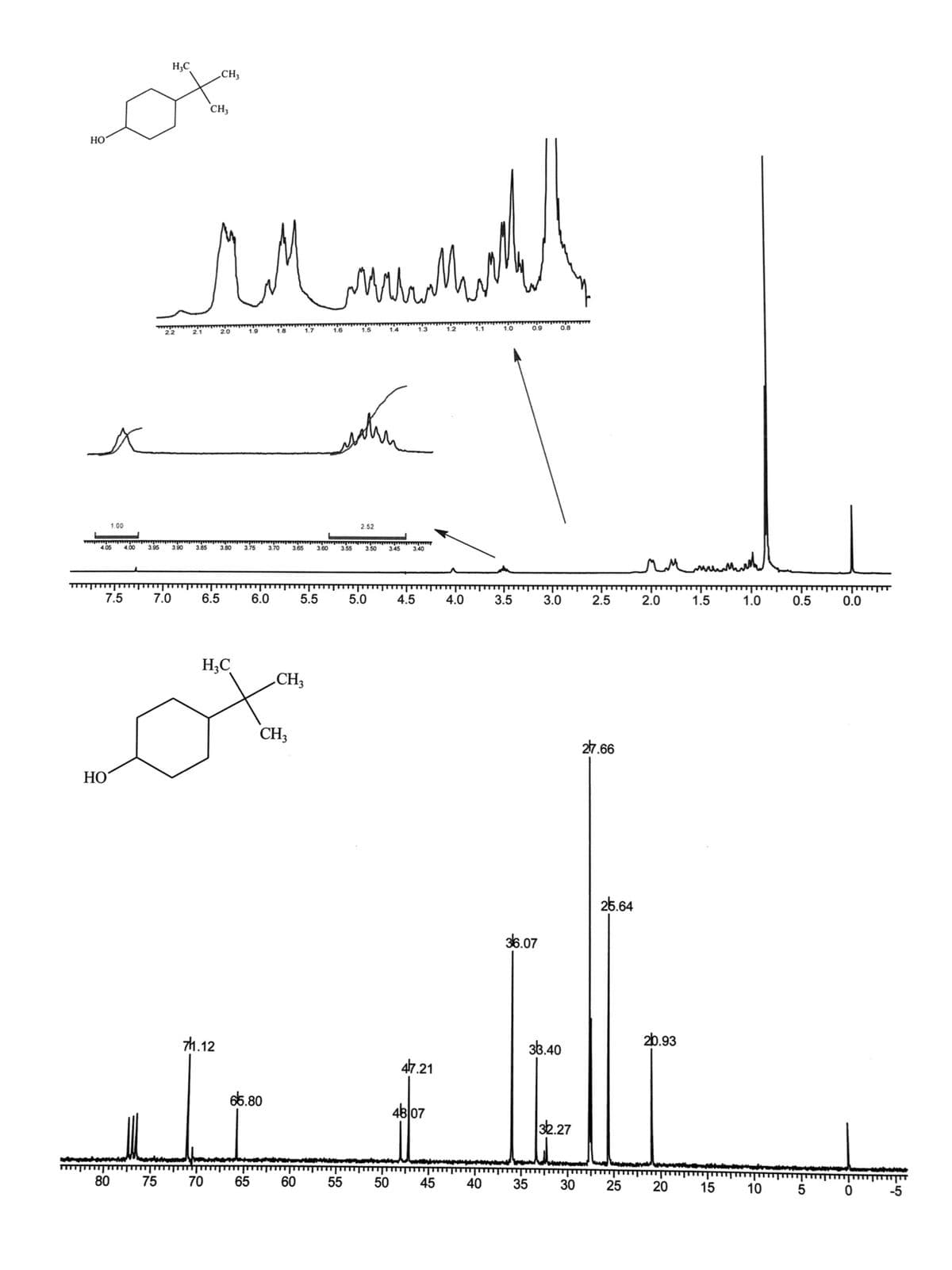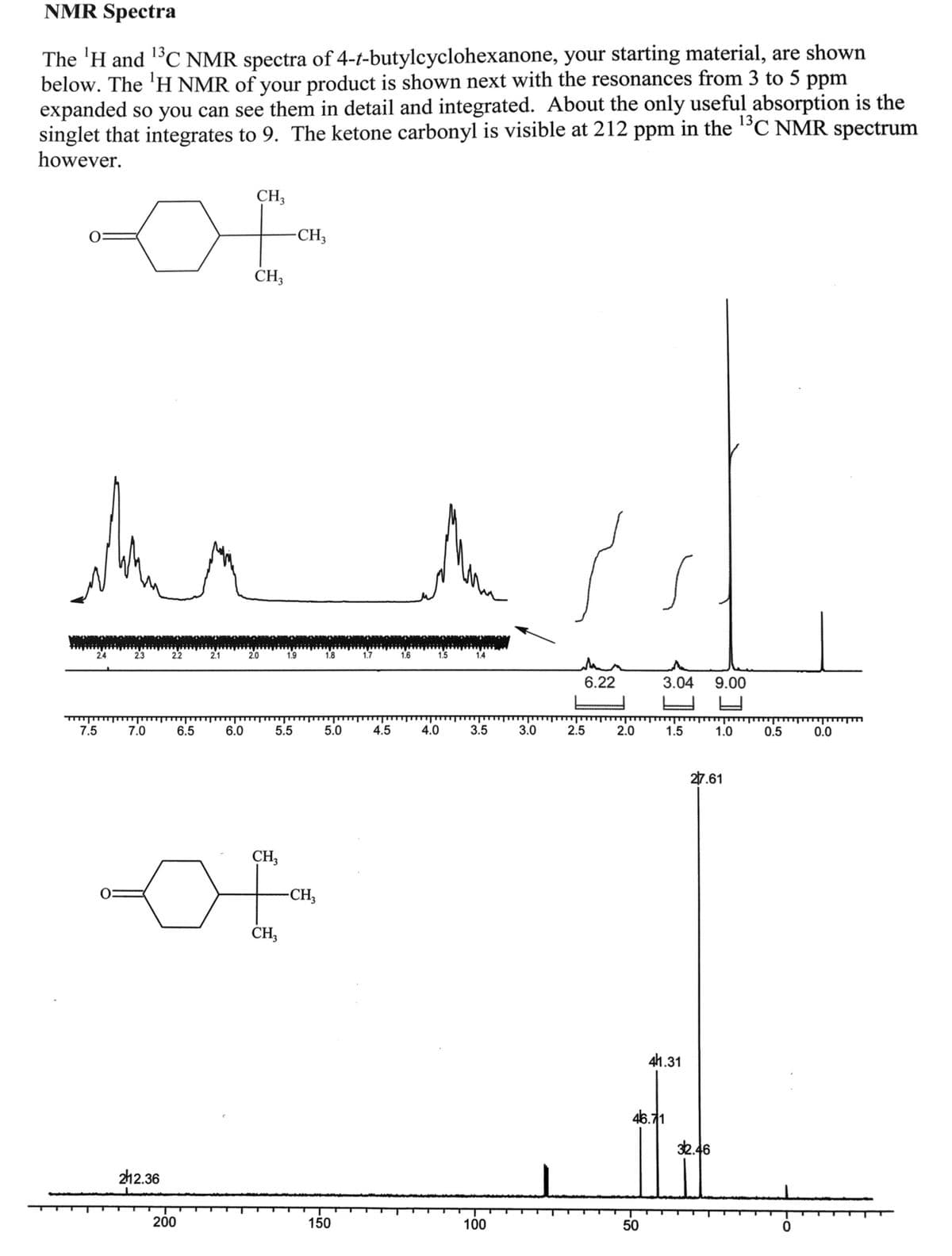In the expanded region of 1H NMR for 4-t-butylcyclohexanols, the peak at 4.05 ppm integrates to 1.0 while the peak at 3.52 ppm integrates to 2.52. Please use this information to calculate the percentage of each isomer in the sample. QUESTION- Based on the 1H NMR, Please explain the cis vs. trans product ratio. Is it consistent with the expected results? Why or why not?
In the expanded region of 1H NMR for 4-t-butylcyclohexanols, the peak at 4.05 ppm integrates to 1.0 while the peak at 3.52 ppm integrates to 2.52. Please use this information to calculate the percentage of each isomer in the sample. QUESTION- Based on the 1H NMR, Please explain the cis vs. trans product ratio. Is it consistent with the expected results? Why or why not?
Chemistry
10th Edition
ISBN:9781305957404
Author:Steven S. Zumdahl, Susan A. Zumdahl, Donald J. DeCoste
Publisher:Steven S. Zumdahl, Susan A. Zumdahl, Donald J. DeCoste
Chapter1: Chemical Foundations
Section: Chapter Questions
Problem 1RQ: Define and explain the differences between the following terms. a. law and theory b. theory and...
Related questions
Question
100%
In the expanded region of 1H NMR for 4-t-butylcyclohexanols, the peak at 4.05 ppm integrates to 1.0 while the peak at 3.52 ppm integrates to 2.52. Please use this information to calculate the percentage of each isomer in the sample.
QUESTION- Based on the 1H NMR, Please explain the cis vs. trans product ratio. Is it consistent with the expected results? Why or why not?

Transcribed Image Text:HO
4.05
х
1.00
7.5
HO
80
7.0
H C
75
6.5
CH₂
CH3
71.12
70
от
CH3
3.70
6.0
65.80
65
смим
edhin
тамирније
3.65 3.60 3.55 3.50 3.45 3.40
5.5
CH3
60
2.52
55
5.0
50
4.5
47.21
48 07
45
4.0
40
1.0
3.5
0.9
36.07
35
0.8
3.0
33.40
32.27
30
2.5
27.66
25.64
25
2.0
20.93
20
1.5
15
1.0
10
0.5
5
----
0.0
0
-5

Transcribed Image Text:NMR Spectra
The 'H and ¹3C NMR spectra of 4-t-butylcyclohexanone, your starting material, are shown
below. The ¹H NMR of your product is shown next with the resonances from 3 to 5 ppm
expanded so you can see them in detail and integrated. About the only useful absorption is the
singlet that integrates to 9. The ketone carbonyl is visible at 212 ppm in the ¹3C NMR spectrum
13,
however.
Ar
7.5
7.0
212.36
6.5
200
CH3
F
CH3
6.0
5.5
CH3
-CH3
CH3
-CH3
5.0
150
4.5
4.0
3.5
100
3.0
6.22
2.5
2.0
3.04
50
1.5
41.31
46.71
9.00
32.46
1.0
27.61
0.5
0
ון
0.0
Expert Solution
This question has been solved!
Explore an expertly crafted, step-by-step solution for a thorough understanding of key concepts.
Step by step
Solved in 3 steps with 6 images

Knowledge Booster
Learn more about
Need a deep-dive on the concept behind this application? Look no further. Learn more about this topic, chemistry and related others by exploring similar questions and additional content below.Recommended textbooks for you

Chemistry
Chemistry
ISBN:
9781305957404
Author:
Steven S. Zumdahl, Susan A. Zumdahl, Donald J. DeCoste
Publisher:
Cengage Learning

Chemistry
Chemistry
ISBN:
9781259911156
Author:
Raymond Chang Dr., Jason Overby Professor
Publisher:
McGraw-Hill Education

Principles of Instrumental Analysis
Chemistry
ISBN:
9781305577213
Author:
Douglas A. Skoog, F. James Holler, Stanley R. Crouch
Publisher:
Cengage Learning

Chemistry
Chemistry
ISBN:
9781305957404
Author:
Steven S. Zumdahl, Susan A. Zumdahl, Donald J. DeCoste
Publisher:
Cengage Learning

Chemistry
Chemistry
ISBN:
9781259911156
Author:
Raymond Chang Dr., Jason Overby Professor
Publisher:
McGraw-Hill Education

Principles of Instrumental Analysis
Chemistry
ISBN:
9781305577213
Author:
Douglas A. Skoog, F. James Holler, Stanley R. Crouch
Publisher:
Cengage Learning

Organic Chemistry
Chemistry
ISBN:
9780078021558
Author:
Janice Gorzynski Smith Dr.
Publisher:
McGraw-Hill Education

Chemistry: Principles and Reactions
Chemistry
ISBN:
9781305079373
Author:
William L. Masterton, Cecile N. Hurley
Publisher:
Cengage Learning

Elementary Principles of Chemical Processes, Bind…
Chemistry
ISBN:
9781118431221
Author:
Richard M. Felder, Ronald W. Rousseau, Lisa G. Bullard
Publisher:
WILEY